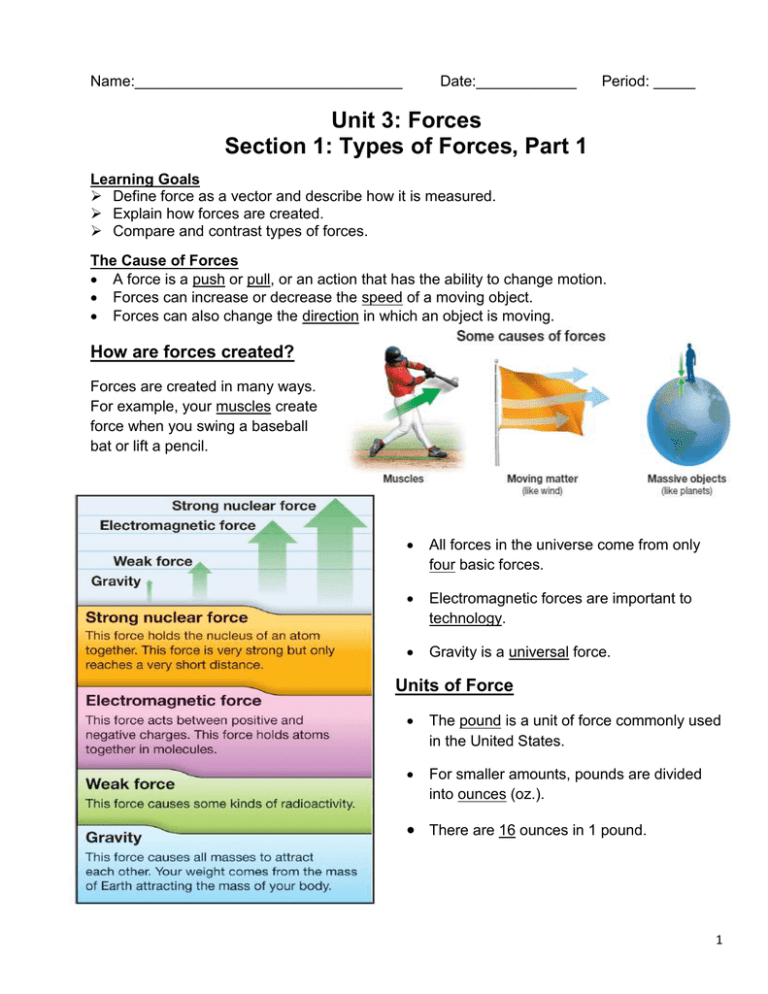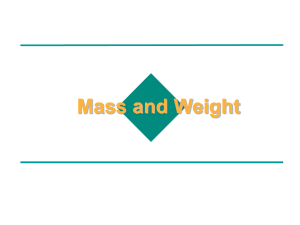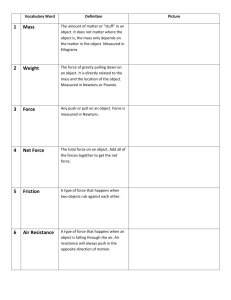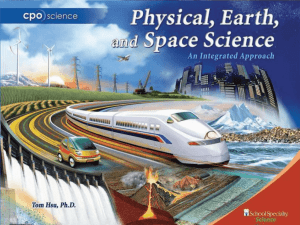Unit 3 Section 1 Notes and Worksheets Answer Key - WAHS
advertisement

Name:________________________________ Date:____________ Period: _____ Unit 3: Forces Section 1: Types of Forces, Part 1 Learning Goals Define force as a vector and describe how it is measured. Explain how forces are created. Compare and contrast types of forces. The Cause of Forces A force is a push or pull, or an action that has the ability to change motion. Forces can increase or decrease the speed of a moving object. Forces can also change the direction in which an object is moving. How are forces created? Forces are created in many ways. For example, your muscles create force when you swing a baseball bat or lift a pencil. All forces in the universe come from only four basic forces. Electromagnetic forces are important to technology. Gravity is a universal force. Units of Force The pound is a unit of force commonly used in the United States. For smaller amounts, pounds are divided into ounces (oz.). There are 16 ounces in 1 pound. 1 When you measure weight in pounds on a postal scale, you are measuring the force of gravity acting on an object. Although we use pounds all the time in our everyday life, scientists prefer to measure forces in newtons. The newton (N) is a metric unit of force. Unit Conversions The newton (N) is a smaller unit of force than the pound (lb). If one pound of force equals 4.448 newtons, then a 100 lb person weighs 444.8 newtons. The Force Vector The direction of a force makes a big difference in what the force does. That means force is a vector, like velocity or position. It can be – or +. We use arrows to show the direction of a force. When drawing forces… The arrow points in the direction of the force. The x- and y-axes show the strength of the force in the x and y directions. When drawing a force vector to show its strength, you must also choose a scale. 1 cm = 1 newton 2 How Forces Act One way forces act is the result of direct contact. A contact force is transmitted by matter directly touching other matter such as wind acting to slow a parachute. The force of gravity between Earth and Moon appears to be what people once called “actionat-a-distance”. Today we know that the gravitational force is carried from the Earth to the Moon by a force field. Classify these types of forces as either contact forces or the result of force fields. Magnetic Force force - pound – 3 newton – Review Questions 1. Name the four ways force is created. a. _______________________ c. ________________________ b. _______________________ d. ________________________ 2. Name the four types of forces. a. _______________________ c. ________________________ b. _______________________ d. ________________________ 3. Name the two units of force. ___________________ and ___________________. 4. What is the difference between contact forces and forces that act through a force field? ________________________________________________________________________ ________________________________________________________________________ 5. Draw a force vector diagram that shows the box below being pulled to the left. If you need help, check page 116 in the textbook, #4. 6. If 1 pound is equal to 4.448 newtons, how many newtons is 5 pounds? Show your conversion equation. __________ x ___________ = ____________ 7. How many newtons would it take to move a box weighing 2 kg at a speed of 1 m/s for 1 second. Need help, check your diagram on page 2 of the notes. 4 Name:________________________________ Date:____________ Period: _____ Unit 3: Forces Section 1: Types of Forces, Part 2 Contact Forces from Ropes and Springs Ropes and springs are often used to make and apply forces. Ropes are used to transfer forces or change their direction. The pulling force carried by a rope is called tension. Tension always acts along the direction of the rope. Spring Forces Springs are used to make or control forces. The force from a spring always acts to return the spring to its resting shape. Which spring in the first picture was meant to be stretched and which one was meant to be compressed? Label your answers on the diagram. Stretched Compressed 5 The force created by a spring is proportional to the ratio of the extended or compressed length divided by the original (resting) length. force created by spring = extended or compressed length/original length If you stretch a spring twice as much, it makes a force that is twice as strong. _____________________________________________________________ Gravity The force of gravity on an object is called weight. At Earth’s surface, gravity exerts a force of 9.8 N on every kilogram of mass. Weight vs. Mass Weight and mass are not the same. Mass is a fundamental property of matter measured in kilograms (kg). Weight is a force measured in newtons (N). Weight depends on mass and gravity. Therefore, your weight can change on the moon, but your mass would not. Solving Problems: Weight and Mass Label the parts of the following equation: W = mg The weight equation can be rearranged into three forms to calculate weight, mass, or the strength of gravity. 6 Example Problem Calculate the weight of a 60-kilogram person (in newtons) on Earth and on Mars. 1. Looking for: weight of person in newtons on both planets Given(s): mass = 60 kg; g = 3.7 N/kg on Mars implied g = 9.8 N/kg on Earth 2. Relationship(s): W = m x g 3. Solutions: 60 kg x 9.8 N/kg = 588 N 60 kg x 3.7 N/kg = 222 N Vocabulary Tension – a pulling force that acts in a rope, string, or other object. Extension – a “stretch” or increase in size. Compression – a “squeeze” or decrease in size. Review Questions 1. Force created by a spring is equal to … ______________________________________________________________ 2. What is the weight in newtons of a bowling ball that has a mass of 3 kilograms? ________________________ 3. An astronaut in a spacesuit has a mass of 100 kilograms. What is the weight of this astronaut in the surface of the Moon where the strength of gravity is approximately 1/6 that of Earth? _______________________ 4. Using the table on page 111 of your textbook, fill in the following chart. Contact Forces “At-a-distance” Forces (Force Fields) Friction Gravity Normal force Electricity Tension, air resistance, spring Magnetism 7 Name: ___________________________ Date: _____________ Period: ______ Unit 3 Section 1: Types of Forces Mass, Weight, and Gravity How do we define mass, weight, and gravity? Mass • Mass is a measure of the amount of matter in an object. Mass is not related to gravity. • The mass of an object does not change when it is moved from one place to another. • Mass is commonly measured in grams or kilograms. Weight • Weight is a measure of the gravitational force between two objects. • The weight of an object does change when the amount of gravitational force changes, as when an object is moved from Earth to the moon. • Weight is commonly measured in newtons or pounds. Gravity • The force that causes all masses to attract one another. The strength of the force depends on the size of the masses and their distance apart. How are mass, weight, and gravity related? The weight equation W = mg shows that an object’s weight (in newtons) is equal to its mass (in kilograms) multiplied by the strength of gravity (in newtons per kilogram) where the object is located. The weight equation can be rearranged to find weight, mass, or the strength of gravity if you know any two of the three. Use… W = mg if you want to find… weight (W) and you know… mass (m) and strength of gravity (g) m = W/g g = W/m mass (m) strength of gravity (g) weight (W) and strength of gravity (g) weight (W) and mass (m) Sample Problems 1. Calculate the weight (in newtons) of a 5.0 kilogram backpack on Earth (g = 9.8 N/kilogram). Solution: W= m(g) W = (5.0 kg) (9.8 N/kg) W = 49 N 2. The same backpack weighs 8.2 newtons on Earth’s moon. What is the strength of gravity on the moon? Solution: g= W/m g = 8.2 N / 5.0 kg g= 1.6 N/kg 8 Practice Problems Show your work on a separate sheet of paper or in the empty space below each problem. 1. A physical science textbook has a mass of 2.2 kilograms. a. What is its weight on Earth? _________________ b. What is its weight on Mars? (g = 3.7 N/kg) _______________ c. If the textbook weighs 19.6 newtons on Venus, what is the strength of gravity on that planet? _____________________ 2. An astronaut weighs 104 newtons on the moon, where the strength of gravity is 1.6 newtons per kilogram. a. What is her mass? ____________________ b. What is her weight on Earth? _____________________ c. What would she weigh on Mars? ____________________ 3. Of all the planets in our solar system, Jupiter has the greatest gravitational strength. a. If a 0.500-kilogram pair of running shoes would weigh 11.55 newtons on Jupiter, what is the strength of gravity there? __________________________ b. If the same pair of shoes weighs 0.3 newtons on Pluto (a dwarf planet), what is the strength of gravity there? _____________________________ c. What does the pair of shoes weigh on Earth? ___________________________ 4. A tractor-trailer truck carrying boxes of toy rubber ducks stops at a weigh station on the highway. The driver is told that the truck weighs 44,000 pounds. a. If there are 4.448 newtons in a pound, what is the weight of the toy-filled truck in newtons? _______________________ b. What is the mass of the toy-filled truck? _______________________ c. The truck drops off its load of toys, then stops at a second weigh station. Now the truck weighs 33,000. pounds. What is its weight in newtons?________________________ d. Challenge! Extra Credit! Find the total mass of the rubber duck-filled boxes that were carried by the truck. _____________________ 9






